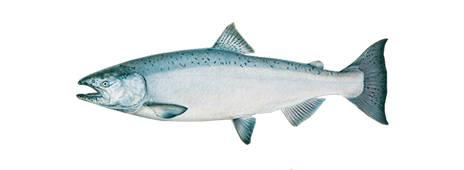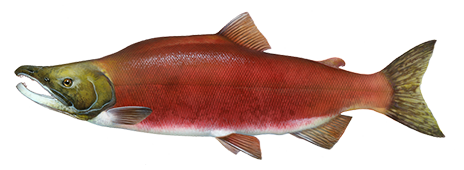Alaska's Salmon Fishery
1979 - 2020
A data visualisation of 41 years of catch data from the Salmon Fishing Industry in Alaska. All data was sourced from the Alaska Department of Fish and Game.
Alaska's salmon fishing industry is one of the world's most sustainable fisheries, having managed to produce billions of pounds of wildcaught salmon and maintain the worlds largest remaining salmon populations for decades.
Salmon fishing is a highly unpredictable business due to the natural variations in fish migrations and restrictions imposed by strict fishing management, a challenge made increasingly difficult by climate change.
Curious about these variations, I created a visualisation of the state's data of the annual Salmon catch in pounds from 1979 to 2020. The data is split between eleven different areas and between the five different salmon species fished in Alaska.
The five species of Pacific Salmon fished in Alaska are...
Chinook
Coho
Sockeye
Chum
Pink
Chinook (King) Salmon usually weigh 10 - 50 pounds in maturity but can weigh up to 126 pounds. They typically measure between 24 and 36 inches but can grow to 58 inches inches. Chinook mature in approximately 3 - 8 years. They spawn (reproduce) early in the summer in large rivers and are typically the earliest salmon to be commercially fished in Alaska. Chinook are caught in the lowest numbers and are the most expensive of the five species.Chinook are processed into fillets that can be quite pricey and are prized for their rich, fatty flavor.

Coho (Silver) Salmon typically weigh 8 - 12 pounds and average 28 inches in length as adults. Coho mature in approximately 4 years and spawn (reproduce) during the late summer and fall in a variety of lake, river and stream environemnts. Coho typically are the third most valued of the five species and produce for fillets, amongth other products.

Sockeye (Red) Salmon weigh 5 - 15 pounds and average 24 inches in length as adults. Sockeye mature in 4 - 5 years and spawn in two 'groups', one in early summer the other in late summer to fall in rivers and streams near lakes. Newly hatched salmon often stay in lakes for 1 - 2 years before migrating back to the ocean. Sockeye salmon are the second most valuable of the five species and usually are processed into fillets and smoked. They are the caught in the second highest volumes in Alaska.

Chum (Dog) Salmon typically weigh 10 - 20 pounds and average 24 inches in length as adults. They spawn in early to mid-summer in smaller rivers and streams and intertidal zones. They migrate directly back to the ocean and mature for 3 - 5 years. Chum are the second least valuable of the five species and are mostly processed into canned or other less fresh products.

Pink (Humpy) Salmon typically weigh 4 - 5 pounds and average 20 inches as adults. They spawn in mid-summer in smaller streams after maturing for 1 - 2 years. After hatching they migrate directly to marine or estuarine environments. Pinks are the least valuable of the five species but are caught in the highest numbers. They are mostly processed into canned or other less fresh products.
